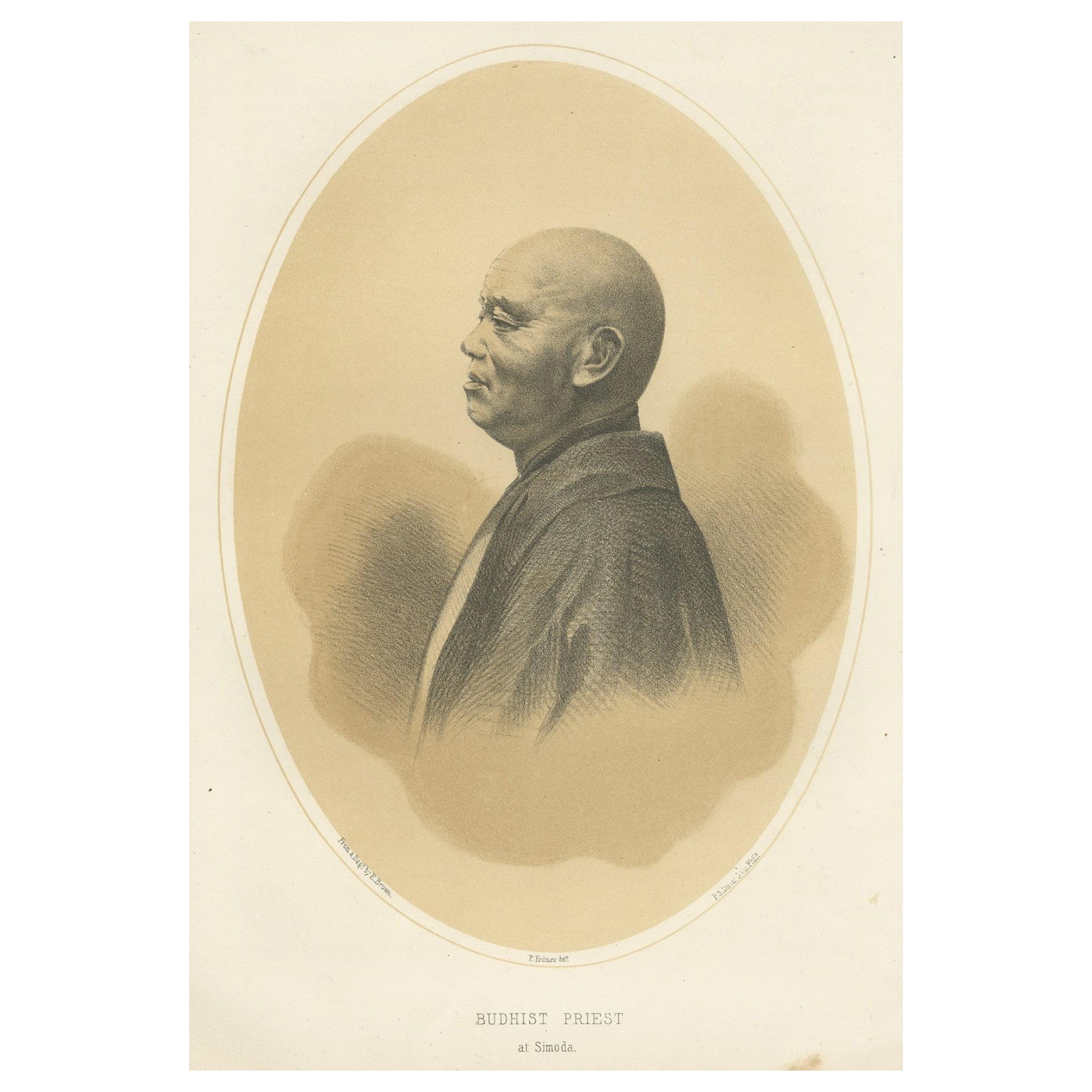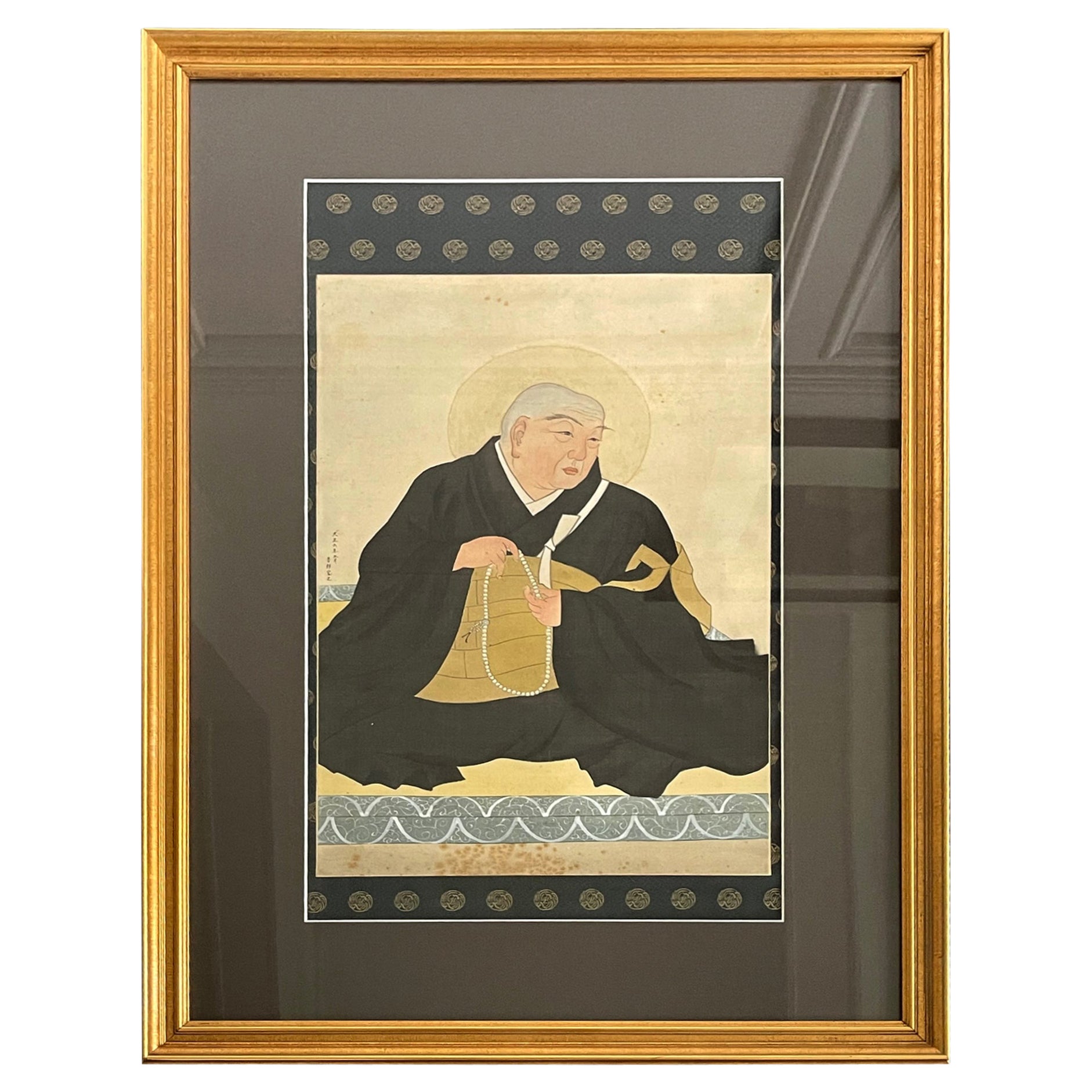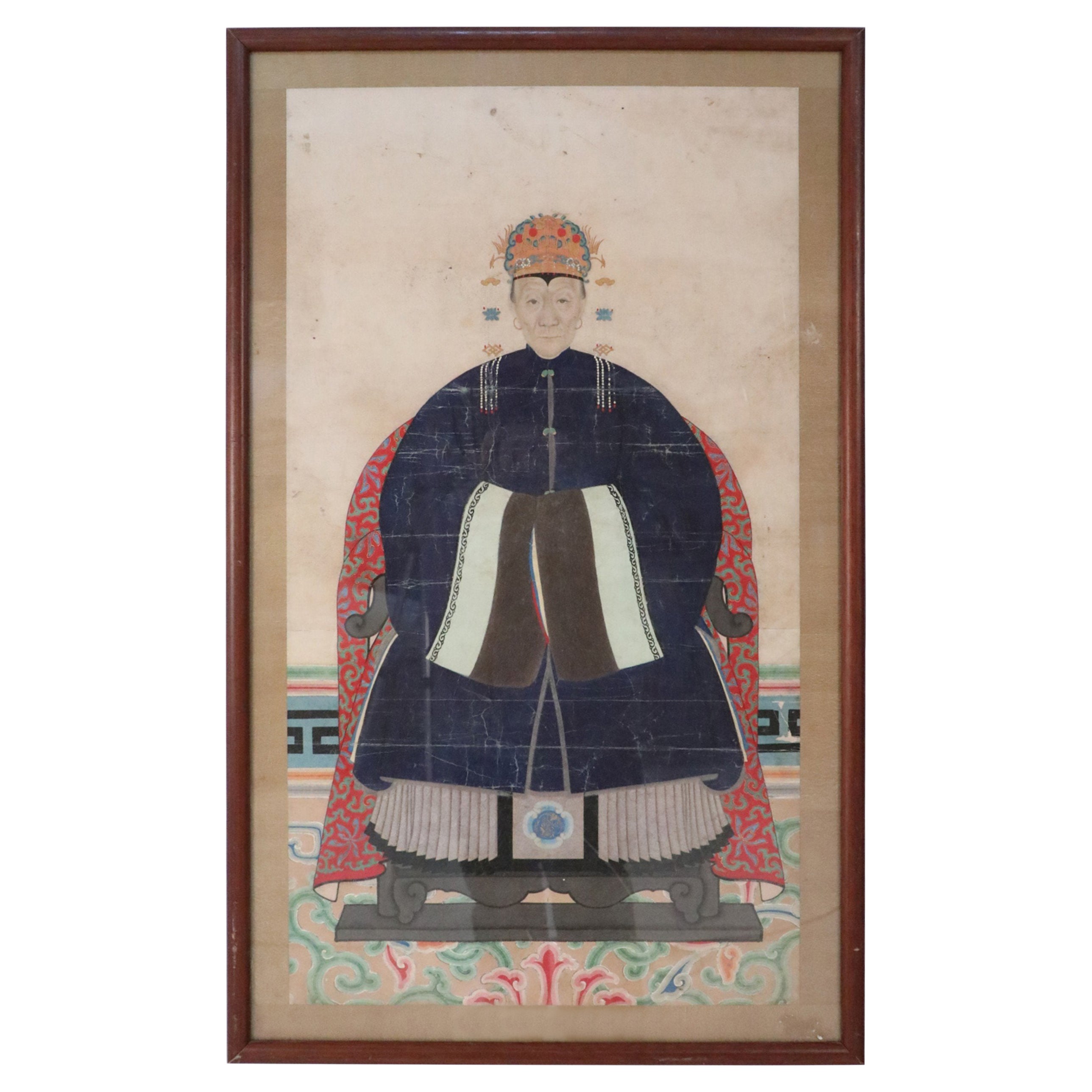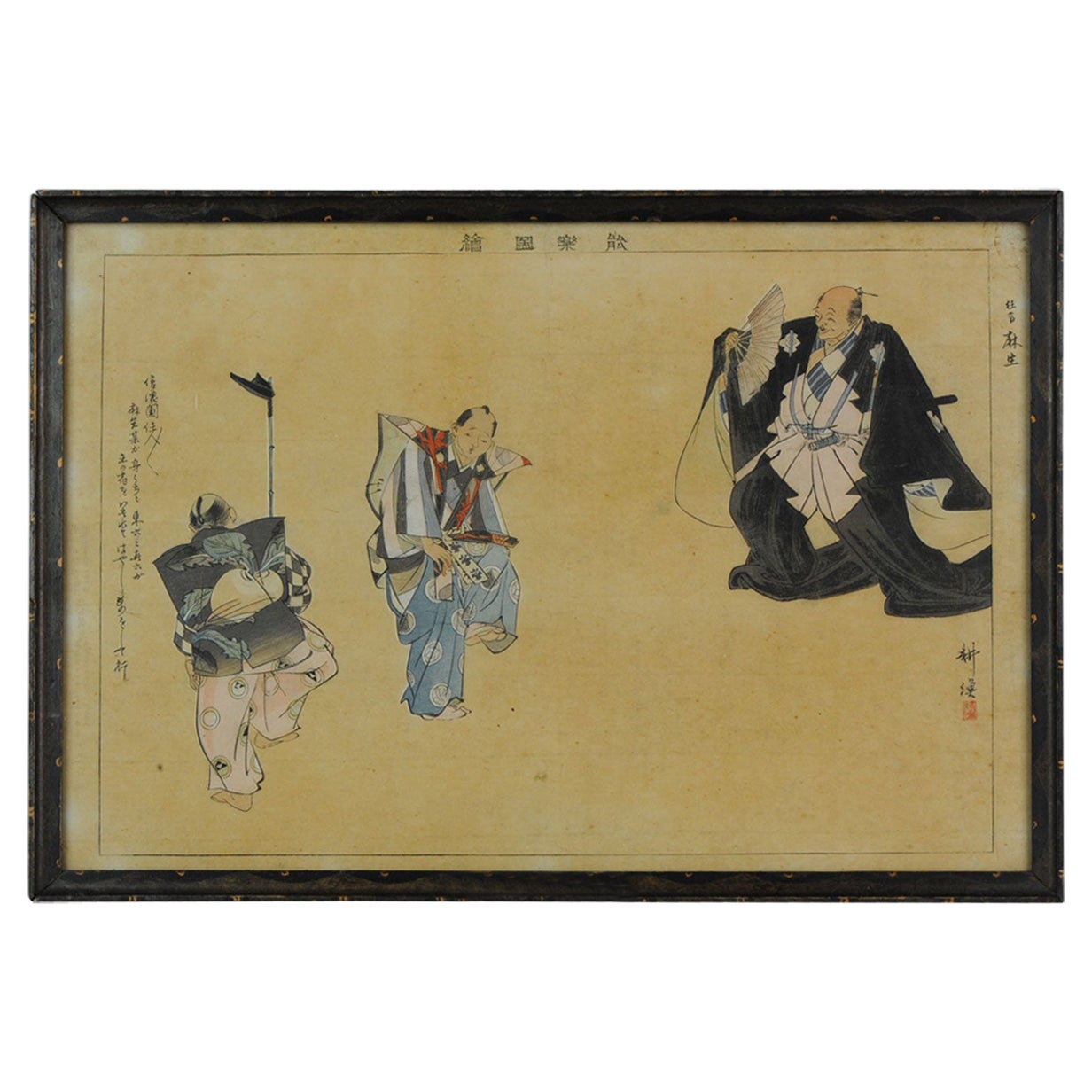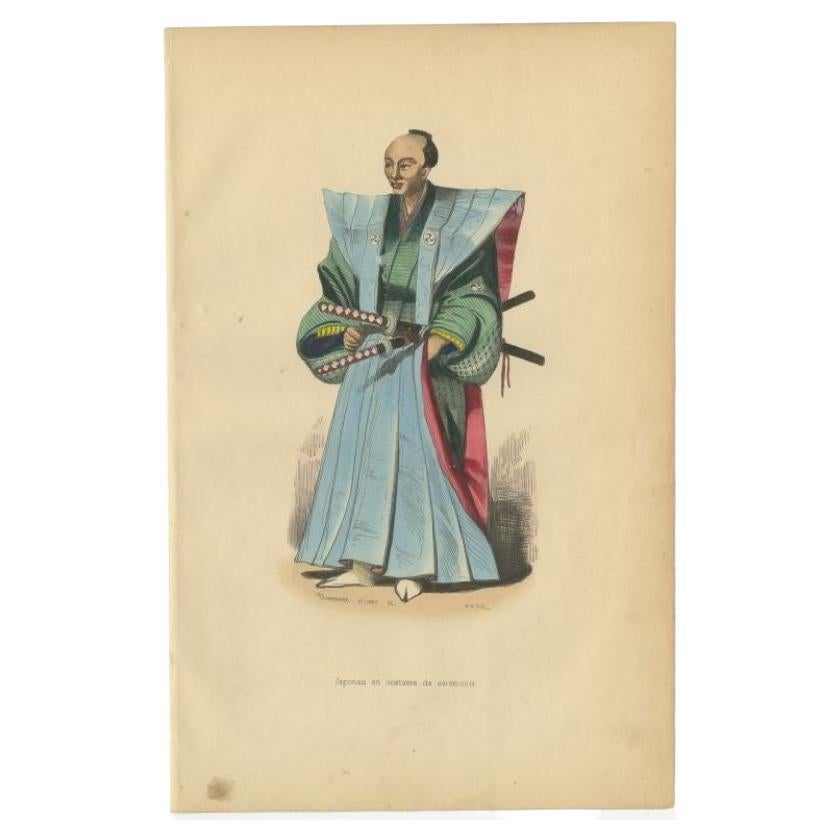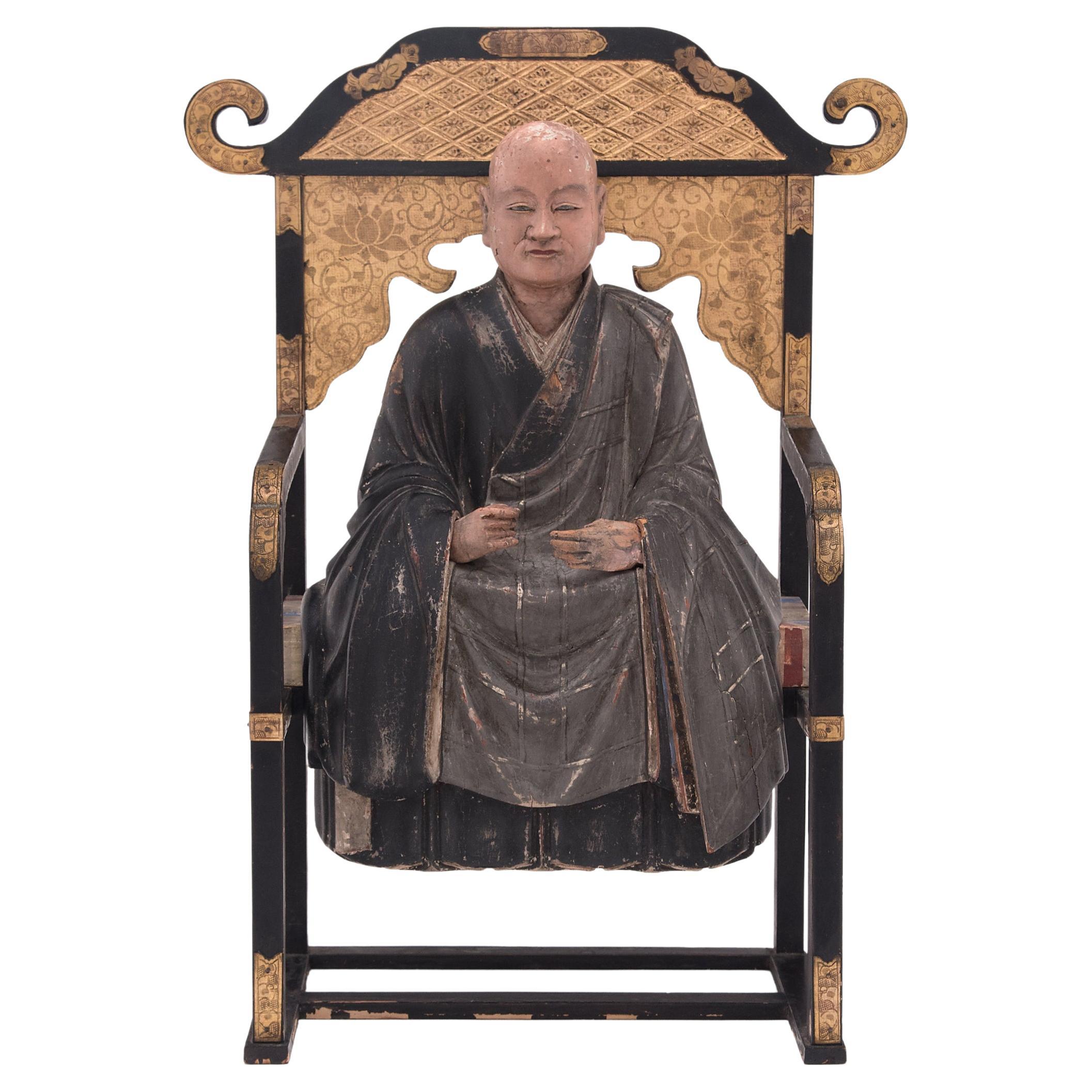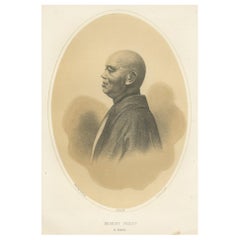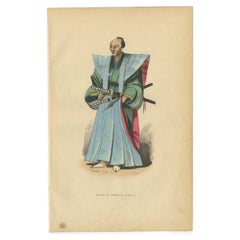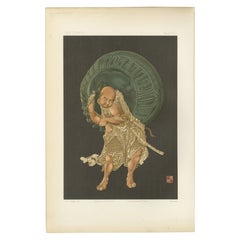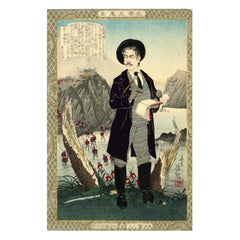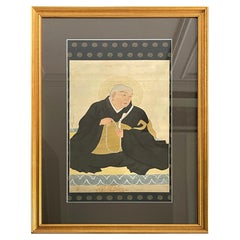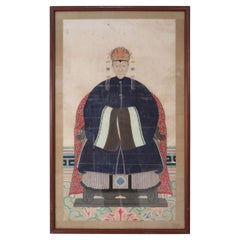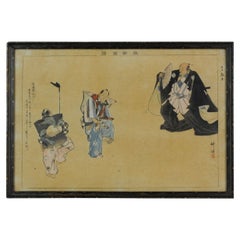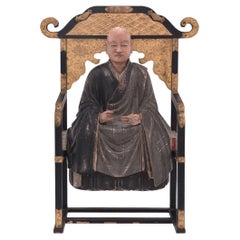Items Similar to 1872 Portrait of the Head Priest of Daiji Temple – Commemorative Lithograph
Want more images or videos?
Request additional images or videos from the seller
1 of 10
1872 Portrait of the Head Priest of Daiji Temple – Commemorative Lithograph
$303.56
$379.4520% Off
£228.14
£285.1720% Off
€256
€32020% Off
CA$425.12
CA$531.4020% Off
A$466.22
A$582.7820% Off
CHF 241.55
CHF 301.9420% Off
MX$5,602.02
MX$7,002.5320% Off
NOK 3,040.68
NOK 3,800.8620% Off
SEK 2,853.77
SEK 3,567.2120% Off
DKK 1,950.81
DKK 2,438.5120% Off
About the Item
This is an antique Japanese lithograph depicting a Buddhist monk or a high-ranking religious figure, seated in traditional robes. The monk is dressed in a rich purple garment adorned with gold accents, which signifies his high spiritual or clerical status. He holds a symbolic religious item, possibly a *shaku* (a ceremonial scepter), in his hands, further emphasizing his role as a leader or teacher within a Buddhist temple or order.
The background is minimal and focuses on the figure, framed by an intricate floral border. Behind the monk, a hanging scroll with calligraphy provides further context, likely a phrase from Buddhist teachings. The text at the bottom suggests that this is a memorial or honorific portrait, commonly used to commemorate important religious figures.
The presence of this ornate border and the detailed hand-coloring of the robes (particularly the rich purple) indicate the importance of the subject. Purple in Japanese culture is often associated with nobility, wisdom, and spirituality, reinforcing the idea that this figure holds a significant religious or spiritual role.
The lithograph likely dates back to the late 19th century, and despite signs of wear, the delicate hand-coloring and precise detail make this a valuable artifact of religious and cultural history in Japan.
Here is the transcription of the Japanese text from the print:
- Text at the bottom of the print:
像真御上教大寺頌水
明治五年九月二十三日図
Translation:
- 像真御上教大寺頌水: "Portrait of the True Image of His Highness, Head Priest of Daiji Temple, Water Praise."
- 明治五年九月二十三日図: "Drawn on the 23rd day of the 9th month of Meiji Year 5" (which corresponds to September 23, 1872).
Interpretation: This print appears to be a commemorative or honorific portrait of a high-ranking monk, possibly the head priest of a Buddhist temple called "Daiji Temple." The phrase "Water Praise" may refer to a title or religious honor bestowed upon the monk. The date places this portrait in the Meiji period, specifically in 1872.
- Dimensions:Height: 20.08 in (51 cm)Width: 14.18 in (36 cm)Depth: 0 in (0.02 mm)
- Materials and Techniques:
- Period:
- Date of Manufacture:1872
- Condition:Fair with general age-related toning and defects from handling, with some yellowing and wear, especially along the edges. An open scratch into the image border in the top right. Study the scans carefully.
- Seller Location:Langweer, NL
- Reference Number:Seller: BG-12246-31stDibs: LU3054341643762
About the Seller
5.0
Recognized Seller
These prestigious sellers are industry leaders and represent the highest echelon for item quality and design.
Platinum Seller
Premium sellers with a 4.7+ rating and 24-hour response times
Established in 2009
1stDibs seller since 2017
2,686 sales on 1stDibs
Typical response time: <1 hour
- ShippingRetrieving quote...Shipping from: Langweer, Netherlands
- Return Policy
Authenticity Guarantee
In the unlikely event there’s an issue with an item’s authenticity, contact us within 1 year for a full refund. DetailsMoney-Back Guarantee
If your item is not as described, is damaged in transit, or does not arrive, contact us within 7 days for a full refund. Details24-Hour Cancellation
You have a 24-hour grace period in which to reconsider your purchase, with no questions asked.Vetted Professional Sellers
Our world-class sellers must adhere to strict standards for service and quality, maintaining the integrity of our listings.Price-Match Guarantee
If you find that a seller listed the same item for a lower price elsewhere, we’ll match it.Trusted Global Delivery
Our best-in-class carrier network provides specialized shipping options worldwide, including custom delivery.More From This Seller
View AllOld Lithograph of a Buddhist priest of Shimoda, Japan, 1856
Located in Langweer, NL
Antique print titled 'Budhist Priest at Simoda'.
Lithograph of a Buddhist priest of Shimoda, Japan. This print originates from 'Narrative of the expe...
Category
Antique 1850s American Religious Items
Materials
Paper
Antique Print of a Japanese Ceremonial Costume, 1843
Located in Langweer, NL
Antique costume print titled 'Japonais en costume de cérémonie'. Original antique print of a Japanese ceremonial costume. This print originates from 'Moeurs, usages et costumes de to...
Category
Antique 19th Century Prints
Materials
Paper
$170 Sale Price
20% Off
The Guardian of the Bell – An Audsley’s Japanese-Inspired Chromolithograph, 1884
Located in Langweer, NL
Title: The Guardian of the Bell – Plate VIII from G. A. Audsley’s Japanese-Inspired Chromolithographic Series
Description: Plate VIII from Section V of G. A. Audsley’s collection is...
Category
Antique 1880s Prints
Materials
Paper
Fukuchi Gen'ichiro, 1885 - Colour Woodblock Print by Kobayashi Kiyochika
Located in Langweer, NL
Title: Fukuchi Gen'ichiro - 1885 Woodblock Print from *Instructive Models of Lofty Ambitions* by Kobayashi Kiyochika
Description: This 1885 color woodblock print, created by the re...
Category
Antique 1880s Prints
Materials
Paper
$493 Sale Price
20% Off
Exceptional Rare Lithograph of Kōnu Genzou from Kyoto in Japan, circa 1880
Located in Langweer, NL
This is an original antique lithograph of a Japanese woman, likely from the Meiji period (1868-1912), as suggested by the style of the kimono and hair accessories. The print shows a ...
Category
Antique 1880s Prints
Materials
Paper
$303 Sale Price
20% Off
Antique Print of a Japanese Ceremonial Costume by Wahlen, 1843
Located in Langweer, NL
Antique costume print titled 'Japonais en Costume de Cérémonie'. Original antique print of a Japanese ceremonial costume. This print originates from 'Moeurs, usages et costumes de to...
Category
Antique Mid-19th Century Prints
Materials
Paper
$94 Sale Price
20% Off
You May Also Like
Framed Japanese Portrait of a Buddhist Priest by Goro Kamenaga
Located in Atlanta, GA
A gouache on silk painting of a Buddhist priest by Japanese painter Goro Kamenaga (1890-1955). The highly realistic painting depicts a figure in seate...
Category
Vintage 1910s Japanese Meiji Paintings and Screens
Materials
Silk
Framed Chinese Pen and Ink Ancestor in Navy Robes Portrait
Located in Queens, NY
Vintage (20th Century) Chinese pen and ink ancestor portrait capturing the honoree seated in a red chair on a patterned floor and wearing an elabor...
Category
20th Century Chinese Chinese Export Paintings
Materials
Wood, Paper, Glass, Walnut
Lovely Japanese Blockprint Made by Kogyo Antique Meiji, 19th Century
Located in Amsterdam, Noord Holland
Interesting and finely painted Japanese painting. Marked Kogyo.
Additional information:
Material: Paper
Type: Paintings, Scrolls & Prints
Region of Origin: Japan
Period: ca 1900
Con...
Category
Antique 19th Century Japanese Prints
Materials
Paper
$398 Sale Price
20% Off
Japanese Seated Portrait of a Zen Master, c. 1800
Located in Chicago, IL
This 19th century Japanese sculpture likely portrays an accomplished teacher of Japanese Zen Buddhism. Developed from wood with a polychrome finish, this monk is expertly carved with...
Category
Antique Early 19th Century Japanese Edo Figurative Sculptures
Materials
Wood
Tsuruya Kokei Signed Limited Edition Japanese Woodblock Print Onoe Kikugoro VII
Located in Studio City, CA
A wonderful and quite rare woodblock print by unique master Japanese artist/ printmaker Tsuruya Kokei. This work is titled "Onoe Kikugoro VII as Kirare Y...
Category
1990s Japanese Showa Prints
Materials
Paper
Antique Chinese Printed Ink Rubbing of Panthaka Arhat, (scroll mounted)
Located in Point Richmond, CA
Chinese ink rubbing printing depicting Panthaka Arhat, no.4 of the 16 arhat images immortalized in stone at the former stupa at Shengyin Temple. Depicted here sitting on a rock with a book in his left hand and snapping his fingers in his right hand, symbolic of the speed at which he obtained enlightenment, accompanied by a beggar’s bowl and an incense burner, complete with colophons and silk scroll mounting. The Emperor Qianlong ordered the stone stele to be carved in 1764 after the arhat designs painted by the famed artist Guanxiu (832-912). Even though the temple was destroyed in the Taiping rebellion, the steles remain and have been reinstalled at the Hangzhou Stele Forest. Condition: Creases from rolling, otherwise fine condition. Mounting: 58” x 22”. 19th Century. Ex Collection: Frank “Till” & Peggy Durdin, San Diego.
For other rubbings of this stele see:
Penn Museum, object number 2010-26-4
The Metropolitan Museum of Art AN#: 59.195.15
Fine Arts Library of Harvard University, record id: W280021_urn-3:FHCL:478850
For another example of this image rendered in jade and lacquer see: “Screen Paintings of Guanxiu’s Sixteen Arhats in the Collection of the Palace Museum” Luo Wehhua translated by Bruce Doar, Orientations, September 2010, p. 104. In this article the image is identified as the sixteenth arhat Abheda, It is explained in this article that Qianlong re-identified the arhats, thus the 16th Arhat attribution for this image. Also in this article the identical colophon by Qianlong above the image is translated as: “These accurate portraits of the Sixteen Arhats were created by the Tang Dynasty painter Guanxiu, as recorded in Xuanhe Huapu (Record of paintings in the Xuanhe Reign), and during the millennium from the Guangming reign period to the present day, the original works were to be found in Zhejiang, where they were housed in the collection of Shengyin Temple in Qiantang (Huangzhou). In spring of the dingchou year (1757) of his reign, the Qianlong emperor undertook a southern tour of inspection and stayed at an imperial lodge on the West Lake. He went to the temple to pay his respects and there he saw the arhats on display and wrote a description of these marvels. The sequence of the arhats and their names had been passed down since ancient times, but they did not correspond to their Sanskrit titles; the sequence of the arhat names conformed instead to the interpretation of the Sanskrit classics by the Zhangjia State Preceptor. The emperor penned the original names and positions in the sequence below each of the figures in accordance with the readings supplied in Tongwen Yuntong (Unified Rhymes), and below each he penned an encomium, which he signed. Then the images were returned to the collection, to be passed down as a perpetual treasure. Now, the fourth great arhat had long gone missing and we did not know where his painting was. But it was merely a trifling matter of matching the images with the names, and now surely we have found him! This I, the emperor, believe.”
All 16 of these rubbings can be found in the Rubel Chinese Rubbings Collection at the Fine Arts Library of Harvard University with the following descriptive historical note: “Rubbing from stele depicting No. 4 of 16 arhats (Lohans, Buddhist saints) -- Nan ti mi duo luo qing you, Panthaka Arhat. Original painting attributed to Guanxiu, 832-912. Inscriptions written by Hongli, Emperor Qianlong (Gaozong, 1711-1799) of Qing Dynasty. 7 seals of Qianlong follow the inscriptions. Script style: in xing shu. Shi liu zun zhe -- "The 16 noble ones" are 16 lohans. Lohans are also called "a-lo-han" based on the transliteration of the Sanskrit term "arhat." (Japanese: Rakan; Chinese: Lohan; Tibetan: Gnas-brtan). Arhats or Arahants are saints or sages said to have renounced nirvana (freedom from the cycle of suffering and rebirth), vowed to remain in the world to protect the Dharma and propagate the Law of the Buddha in order to devote themselves more effectively to the relief of human misery, like the Bodhisattvas. These 16 Arhats, personal disciples distinguished by the Buddha, formed part of the 500 claimed by tradition to have attended the First Council in Rajagrha. The names and abodes of these 16 arhats are given in a work entitled "Record on the Duration of the Law, spoken by the Great arhat Nadimitra," which was translated into Chinese by the famous pilgrim Xuanzang (596-664) in 654. 16 lohans are quite often represented, especially in China and Japan, in sculpture and painting, in poses and with attributes. Every lohan can be easily with special icongraphic characteristics. Guanxiu (Jiang Deyin or Deyuan, a Buddhist monk also named Master Chan Yue, 832-912) -- painter during late Tang to Five Dynasties, specialized in painting lohan figures. Legend has it that the first portraits of the 18 Lohans...
Category
Antique 19th Century Chinese Qing Prints
Materials
Paper
More Ways To Browse
Vintage Rooster Plates
Vintage Stetson
Vintage Sunroom Furniture
Vintage Wall Thermometer
Vintage Woodworking Tools
Wall Secretary
Wheat Pattern
Whimsical Pottery
White Ceramic Elephant
White Lion Sculpture
White Swedish Commode
Wood Hand Carved Painted Chinese Statues
Wood Hindu
Zebra Cushion
15th Century Chinese Porcelain
1933 Worlds Fair
1950s Vintage Television
1970s Drexel
